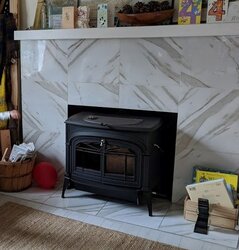This is my second Vermont Castings wood stove. The first was a behemoth Defiant, and now I'm on to an Encore. The stove is set into an existing fireplace by about 1/4 deep, rear exit to a 90 and straight up the existing external chimney via stainless liner.
I feel like I should be getting way more heat out of this thing than I've been getting. I stand right next to it, and can feel warmth, but the rest of the place just takes forever to heat up.
The house isn't insulated. It's at the top of my list of things to get done.
I haven't peeked up inside where the chimney goes up the flu. I'm not positive the installers blocked off the rectangular flu hole around the round stove pipe liner.
The main room, with the fireplace, has three windows, two are big, about 5ft by 6ft each. Double pane, un-opening.
I also think the stove has it's air-inlet right there in my living room. That might create a negative pressure and bring in air from outside.
Any ideas on where I could start looking to make this room warmer? Thanks!
Looky-roundy pic: https://photos.app.goo.gl/HF4eKL7qrYAXxEth9
and this current pic of the stove

I feel like I should be getting way more heat out of this thing than I've been getting. I stand right next to it, and can feel warmth, but the rest of the place just takes forever to heat up.
The house isn't insulated. It's at the top of my list of things to get done.
I haven't peeked up inside where the chimney goes up the flu. I'm not positive the installers blocked off the rectangular flu hole around the round stove pipe liner.
The main room, with the fireplace, has three windows, two are big, about 5ft by 6ft each. Double pane, un-opening.
I also think the stove has it's air-inlet right there in my living room. That might create a negative pressure and bring in air from outside.
Any ideas on where I could start looking to make this room warmer? Thanks!
Looky-roundy pic: https://photos.app.goo.gl/HF4eKL7qrYAXxEth9
and this current pic of the stove


